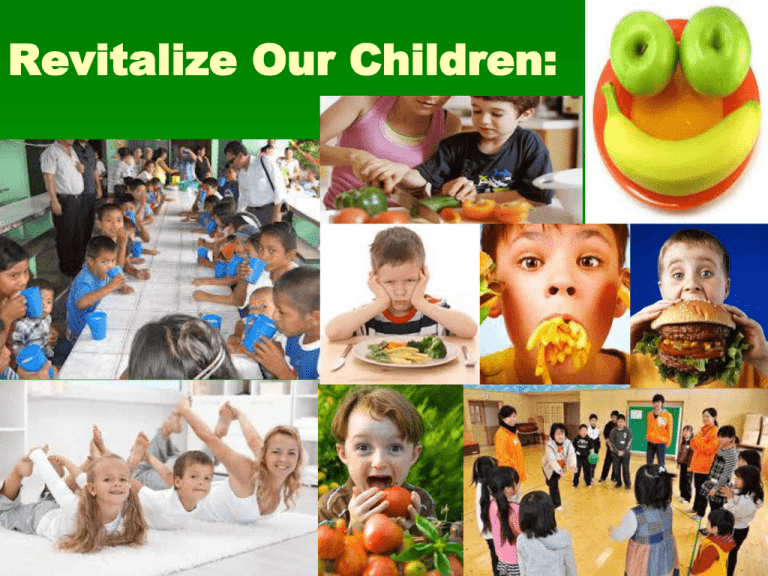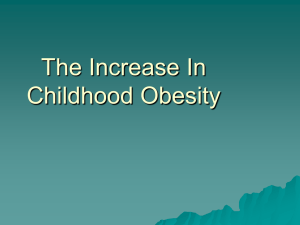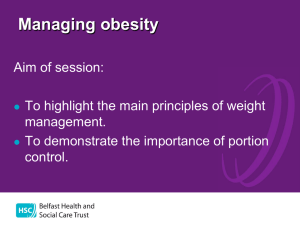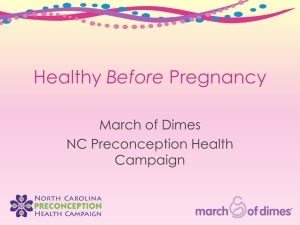
Revitalize Our Children:
Revitalize Our Children:
How health care providers can
understand and help our overweight
children
Revitalize Our Children:
Objectives:
Review prevalence of pediatric obesity
Identify co morbidities of overweight
conditions in children
Identify risk factors for pediatric obesity
Suggest prevention and treatment strategies
David B. Jack, M.D.
Corpulence
Obesity now affects 17% of all children
and adolescents in the United States triple the rate from just one generation
ago
Since 1980, obesity prevalence among
children and adolescents has almost
tripled
Background Differences
There are significant racial and ethnic
disparities in obesity prevalence among
U.S. children and adolescents. In 2007—
2008, Hispanic boys, aged 2 to 19 years,
were significantly more likely to be obese
than non-Hispanic white boys, and nonHispanic black girls were significantly
more likely to be obese than nonHispanic white girls.
2009—2011 County Obesity
Prevalence Among Low-Income Children
Aged 2 to 4 Years
Washington ranks 18 in overall
prevalence with 29.5% of children
considered either overweight or obese.
Washington State:
% Children Ages 6- 17 with TV in Bedroom:
32.0%
% Children Ages 12-17 Not Eating Family Meals Most
Days of Week:
25.8%
From: Prevalence of Obesity and Trends in Body Mass Index Among US Children and Adolescents, 1999-2010
JAMA. 2012;307(5):483-490. doi:10.1001/jama.2012.40
Copyright © 2012 American Medical
Association. All rights reserved.
What Causes Childhood Obesity?
Sugar drinks and less healthy foods
on school campuses.
About 55 million school-aged children are enrolled in
schools across the United States, and many eat and
drink meals and snacks there
More than half of U.S. middle and high schools still
offer sugar drinks and less healthy foods for purchase
Students have access to sugar drinks and less healthy
foods at school throughout the day from vending
machines and school canteens and at fundraising
events, school parties, and sporting events
Advertising of less healthy foods.
Nearly half of U.S. middle and high schools
allow advertising of less healthy foods, which
impacts students' ability to make healthy food
choices
Foods high in total calories, sugars, salt, and
fat, and low in nutrients are highly advertised
and marketed through media targeted to
children and adolescents, while advertising for
healthier foods is almost nonexistent in
comparison
Lack of daily, quality physical activity
Most adolescents fall short of the 2008
Physical Activity Guidelines for Americans
recommendation of at least 60 minutes of
aerobic physical activity each day, as only 18%
of students in grades 9—12 met this
recommendation in 2007
Daily, quality physical education in school can
help students meet the Guidelines. However, in
2009 only 33% attended daily physical
education classes
No safe and appealing place, in many
communities, to play or be active.
Many communities are built in ways that make
it difficult or unsafe to be physically active. For
some families, getting to parks and recreation
centers may be difficult, and public
transportation may not be available. For many
children, safe routes for walking or biking to
school or play may not exist. Half of the
children in the United States do not have a
park, community center, and sidewalk in their
neighborhood. Only 27 states have policies
directing community-scale design.
Limited access to healthy affordable foods
Some people have less access to stores and
supermarkets that sell healthy, affordable food such as
fruits and vegetables, especially in rural, minority, and
lower-income neighborhoods
Supermarket access is associated with a reduced risk
for obesity
Choosing healthy foods is difficult for parents who live
in areas with an overabundance of food retailers that
tend to sell less healthy food, such as convenience
stores and fast food restaurants
Greater availability of high-energy-dense foods
and sugar drinks.
High-energy-dense foods are ones that have a lot of
calories in each bite
A high-energy-dense diet is associated with a higher
risk for excess body fat during childhood
Sugar drinks are the largest source of added sugar and
an important contributor of calories in the diets of
children in the United States
High consumption of sugar drinks, which have few, if
any, nutrients, has been associated with obesity
On a typical day, 80% of youth drink sugar drinks
Increasing portion sizes
Portion sizes of less healthy foods and
beverages have increased over time in
restaurants, grocery stores, and vending
machines
Children eat more without realizing it if
they are served larger portions
Lack of breastfeeding support.
Breastfeeding protects against childhood overweight
and obesity
However, in the United States, while 75% of mothers
start out breastfeeding, only 13% of babies are
exclusively breastfed at the end of 6 months
The success rate among mothers who want to
breastfeed can be improved through active support
from their families, friends, communities, clinicians,
health care leaders, employers, and policymakers.
Children who are breastfed for six months are less
likely to become obese
Television and Media
Children 8—18 years of age spend an
average of 7.5 hours a day using
entertainment media, including TV,
computers, video games, cell phones,
and movies. Of those 7.5 hours, about
4.5 hours is dedicated to viewing TV
Television and Media
Eighty-three percent of children from 6
months to less than 6 years of age view
TV or videos about 1 hour and 57
minutes a day
Television and Media
TV viewing is a contributing factor to
childhood obesity because it may take
away from the time children spend in
physical activities; lead to increased
energy intake through snacking and
eating meals in front of the TV; and,
influence children to make unhealthy
food choices through exposure to food
advertisements
Health Risks Now
Childhood obesity can have a harmful effect on
the body in a variety of ways. Obese children
are more likely to have–
High blood pressure and high cholesterol, which are
risk factors for cardiovascular disease (CVD). In one
study, 70% of obese children had at least one CVD
risk factor, and 39% had two or more
Increased risk of impaired glucose tolerance, insulin
resistance and type 2 diabetes
Health Risks Now
Childhood obesity can have a harmful
effect on the body in a variety of ways.
Obese children are more likely to have–
Breathing problems, such as sleep apnea,
and asthma
Joint problems and musculoskeletal
discomfort
Health Risks Now
Childhood obesity can have a harmful effect on
the body in a variety of ways. Obese children
are more likely to have–
Fatty liver disease, gallstones, and gastroesophageal reflux (i.e., heartburn)
Obese children and adolescents have a greater risk
of social and psychological problems, such as
discrimination and poor self-esteem, which can
continue into adulthood
Health Risks Later In Life
Obese children are more likely to become
obese adults
Adult obesity is associated with a number of serious
health conditions including heart disease, diabetes,
and some cancers
If children are overweight, obesity in adulthood
is likely to be more severe
Young children ages 2 to 5 have a lower prevalence of
overweight and obesity than older youth.
Among young people ages 2 to 19:
About 31.8 percent are considered to be either
overweight or obese, and 16.9 percent are
considered to be obese
About 1 in 3 boys (33 percent) are considered
to be overweight or obese, compared with 30.4
percent of girls
About 18.6 percent of boys and 15 percent of
girls are considered to be obese
Children and Adolescents Ages 6 to 19:
Almost 1 in 3 (33.2 percent) are considered to be
overweight or obese, and 18.2 percent are
considered to be obese
More than 2 in 5 black and Hispanic youth (more
than 41 percent) are considered to be overweight or
obese*
About 25.7 percent of black, 22.9 percent of
Hispanic, and 15.2 percent of white youth are
considered to be obese*
Ogden CL, Carroll MD, Kit BK, Flegal KM. Prevalence of obesity and trends in body mass
index among US children and adolescents, 1999–2010. Journal of the American Medical
Association. 2012; 307(5):483–90.
Childhood Obesity
Obesity now affects 17% of all children
and adolescents in the United States triple the rate from just one generation
ago
Since 1980, obesity prevalence among
children and adolescents has almost
tripled
How Do We Diminish the Problem?
Build a Healthy Plate With Fruits
• Build a Healthy Plate With Vegetables
• Build a Healthy Plate With Dry Beans and Peas
• Meat and Meat Alternates
• Build a Healthy Plate With Whole Grains
• Build a Healthy Plate With Less Salt and Sodium
• Fats and Oils: Build a Healthy Plate With Options Low in
Solid Fats
• Build a Healthy Plate With Less Added Sugars
• Make Water Available Throughout the Day
• Provide Opportunities for Active Play Every Day
• Encourage Active Play and Participate With Children
• Promote Active Play Through Written Policies and Practices
• Limit Screen Time
• Appendix B: Care for Children With Food Allergies (updated
1/17/13)
•
Fat Prevention Begins At Home
Fat Prevention Begins At Home
Make Meal Times a Family Affair
Be a Good Role Model -----
Not a Poor Example
Beans and Peas
Help children feel full longer and maintain a healthy
weight
Promote proper digestion and make children’s
“potty time” easier by providing dietary fiber
Add shape, texture, and flavor to children’s plates
Fruits, Vegetables
Add color, texture, and flavor to children’s plates
Give children the vitamins and minerals they need
to grow and play
Add color, crunch, and flavor to children’s plates
Promote proper digestion, help children feel full,
and provide fiber for fullness
Decreasing Solid Fats
Make food fun
“Kangaroo Pockets” (stuff half a whole-grain pita pocket with
sliced chicken, romaine lettuce, shredded carrots, and a little
salad dressing)
Try “Crunchy Baked Chicken” (oven-baked chicken tenders
coated in crushed whole-grain cereal or breadcrumbs)
Have children help with cooking and
let them choose healthy foods
Decreasing Solid Fats
Have children help cook
Make a “fruit and yogurt parfait” by topping nonfat plain yogurt
with whole-grain cereal and fresh or frozen berries, banana
slices, fruit canned in 100% juice, a favorite fruit
Encourage Active Play
Display posters and pictures of children
and adults being physically active.
Encourage Active Play
Make a chart for tracking physical activity
with children’s and child care providers’
names
Have children place a sticker or a stamp by
their name every time they participate in
active play
Intermountainlive.org
Limit Screen Time
Play music
Limit Screen Time
Organize puzzle time
Have easy puzzles children can do alone or
in pairs
Limit Screen Time
Draw, color, create a sculpture, or use
play dough
Limit Screen Time
Read with or to children; Provide books
Limit Screen Time
Limit Screen Time
Having the TV on can disturb children’s
sleep and play, even if it is on in the
background
Limit Screen Time
TV and some DVDs include
advertisements for unhealthy foods
Limit Screen Time
The more time children spend playing
video games, the more likely they are to
have difficulty concentrating in school
Limit Screen Time
Many video games contain violence
Computer games can impair children’s
sleep at night, possibly causing them to
spend less time in deep sleep. Sleep is
important for children’s health and
development
Limit Screen Time
We know from research that, at least for
boys, the more time they spend playing
video games and watching TV, the less
active they are
Mistreatment
Almost 100% of obese teenage girls
have been at least verbally abused about
their weight
Studies show discrimination in school
and work settings and in dating and
relationships
Body Image
“Skinny” is the only good body type
One quarter of all girls age 6 and 7 have
dieted
Dieting numbers nearly identical for average
and overweight girls
Body Image
“No one at school eats
lunch because they
don’t want to get fat.”
Food Discussions
Emphasize health, not weight
Discuss food in terms of its capacity to provide
energy, and to improve thinking and strength
Do not allow “fat talk”
Love children and ourselves
Support children in hobbies and passions that have
nothing to do with weight
Value their accomplishments
Change the Model
Do not make parties about cupcakes, ice
cream, brownies and Cheetos
Try different kinds of foods as a treat
Do not associate parties with sugar and
fat food indulgences---fun does not just
come with lots of sugar!
Personal Experience
David Gourley Elementary School
Disadvantaged neighborhood
Half of students do not speak English
Attended by speaker 50 years ago when it
first opened
Little community support
Became a “Health Mentor”
Congratulations To
___
___
for Outstanding Achievements and Participation in the
Gold Medal Schools Program for the
2007-2008 School Year
_______________________
GMS Mentor
_____________
Date
References
1.) Barlow SE and the Expert Committee. Expert committee recommendations regarding the
prevention, assessment, and treatment of child and adolescent overweight and obesity:
summary report. Pediatrics 2007;120 Supplement December 2007:S164—S192.
2.) Freedman DS, Mei Z, Srinivasan SR, Berenson GS, Dietz WH. Cardiovascular risk factors
and excess adiposity among overweight children and adolescents: the Bogalusa Heart Study. J
Pediatr. 2007;150(1):12—17.e2.
3.) Whitlock EP, Williams SB, Gold R, Smith PR, Shipman SA. Screening and interventions for
childhood overweight: a summary of evidence for the US Preventive Services Task Force.
Pediatrics. 2005;116(1):e125—144.
4.) Han JC, Lawlor DA, Kimm SY. Childhood obesity. Lancet. May 15 2010;375(9727):1737—
1748.
5.) Sutherland ER. Obesity and asthma. Immunol Allergy Clin North Am. 2008;28(3):589—602,
ix.
6.) Taylor ED, Theim KR, Mirch MC, et al. Orthopedic complications of overweight in children
and adolescents. Pediatrics. Jun 2006;117(6):2167—2174.
7.) Dietz W. Health consequences of obesity in youth: Childhood predictors of adult disease.
Pediatrics 1998;101:518—525.
8.) Swartz MB and Puhl R. Childhood obesity: a societal problem to solve. Obesity Reviews
2003; 4(1):57—71.
References, cont.
9.) Biro FM, Wien M. Childhood obesity and adult morbidities. Am J Clin
Nutr. May 2010;91(5):1499S—1505S.
10.) Whitaker RC, Wright JA, Pepe MS, Seidel KD, Dietz WH. Predicting
obesity in young adulthood from childhood and parental obesity. N Engl J
Med 1997;37(13):869—873.
11.) Serdula MK, Ivery D, Coates RJ, Freedman DS. Williamson DF.
Byers T. Do obese children become obese adults? A review of the
literature. Prev Med 1993;22:167—177.
12.) National Institutes of Health. Clinical Guidelines on the Identification,
Evaluation, and Treatment of Overweight and Obesity in Adults: the
Evidence Report. Bethesda, MD: National Institutes of Health, U.S.
Department of Health and Human Services; 1998.
13.) Freedman DS, Khan LK, Dietz WH, Srinivasan SR, Berenson GS.
Relationship of childhood overweight to coronary heart disease risk
factors in adulthood: The Bogalusa Heart Study. Pediatrics
2001;108:712—718.









